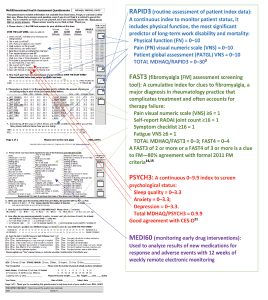
Laura Mahony PhotographY; I Believe I Can Fly / shutterstock.com
The patient medical history is far more prominent in clinical decisions for rheumatology than for many common chronic diseases in which a gold standard biomarker, such as blood pressure or serum glucose, is applicable to diagnosis and management of all individual patients.1 Components of a subjective patient history may be recorded as structured, quantitative, standard, protocol-driven, scientific self-reported data on a patient questionnaire rather than as narrative descriptions.2,3
The multidimensional health assessment questionnaire (MDHAQ) includes RAPID3 (routine assessment of patient index data), a 0–30 index of three 0–10 visual numeric scales (VNS) of physical function, pain and patient global assessment (see Figure 1).4,5 In about five seconds, RAPID3 gives information for rheumatoid arthritis (RA) similar to disease activity score 28 (DAS28) or the clinical disease activity index (CDAI), which require about 100 seconds to score.6 The ACR has endorsed RAPID3 as an outcome measure for RA, and it appears as widely used in U.S. clinical practice as any quantitative clinical index, perhaps in part because it is informative to monitor all rheumatic diseases studied.7-9
Many clinicians, pharmaceutical companies, patient advocacy groups and even the ACR website have extracted only RAPID3, which constitutes about 30% of the MDHAQ, for use—limiting the questionnaire’s clinical value. The full MDHAQ content includes a VNS for fatigue; a self-reported RADAI (RA disease activity index) painful joint count, which is useful in many rheumatic diseases; a 60-symptom checklist to serve as a review of systems and help clinicians recognize potential adverse events of medications; and recent medical history queries.4,10-12 In fact, the full MDHAQ adds considerable incremental information to RAPID3 and requires only 5–10 minutes of the patient’s time to complete vs. 2–5 minutes to complete only the RAPID3 section, ultimately saving time for both the doctor and patient.6 Example: Recent reports have documented that fibromyalgia assessment screening tools (FAST) on the MDHAQ, composed of the 60-symptom checklist, RADAI self-report painful joint count, and pain VNS and/or fatigue VNS, agree more than 80% with the polysymptomatic distress scale, a different questionnaire that constitutes the formal, revised 2011 fibromyalgia criteria.13-15
The full MDHAQ adds considerable incremental information to RAPID3 & takes just 5–10 minutes of the patient’s time to complete.
We present here a case report that illustrates three new applications of the MDHAQ involving RAPID3 and the 60-symptom checklist: 1) RAPID3 is informative to document substantial clinical improvement in a patient with a non-rheumatic disease, pulmonary fibrosis, based on routine MDHAQ completion in the rheumatology clinic waiting area; 2) the symptom checklist on a remote electronic MDHAQ, completed at home by a patient, can recognize adverse events to a medication; and 3) weekly remote electronic MDHAQ completion without face-to-face visits can be effective to document resolution of adverse events and subsequent clinical improvement.

